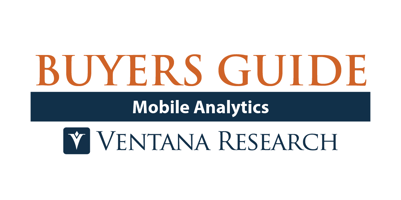The 2023 Ventana Research Buyers Guide for Mobile Analytics research enables me to provide observations about how the market has advanced.
The processes and technology of the mobile analytics software industry play an instrumental role in enabling an organization’s business units and IT to optimally utilize data in both  tactical and strategic ways. To accomplish this, organizations must provide technology that can access the data, generate and apply insights from analytics, communicate the results and support collaboration as needed.
tactical and strategic ways. To accomplish this, organizations must provide technology that can access the data, generate and apply insights from analytics, communicate the results and support collaboration as needed.
For analytics to be effective, they need to be available to line-of-business personnel as needed in their normal course of conducting business, which today means providing rich mobile access to analytics to support a mobile workforce seeking to conduct business in any location at any time. Workers today expect these mobile capabilities, so organizations must make choices to provide analytics platforms that can deliver. Many of these workers switch between desktop/laptop devices when in the office to mobile devices when outside the office or even when attending an internal meeting, so integration between these two modes is important as well.
This Buyers Guide assessment focuses on the challenge of delivering analytics and business intelligence (BI) on a variety of mobile devices including smartphones and tablets. When it comes to smaller devices such as smartphones, it may not be realistic to expect full-blown analyses due to the small form factor, but screen resolution on larger devices such as tablets can support nearly any type of functionality that mobile personnel may need. These needs are substantial: two-thirds of organizations (67%) consider it important to access analytics from mobile devices and more than two-fifths (45%) of organizations report that it is important or very important to be able to address data preparation tasks on mobile devices.
Analytics vendors are divided in their approach to providing mobile capabilities. Many vendors have invested in developing applications that are native to the two platforms that dominate the mobile landscape: Apple’s iOS and Google’s Android operating system. Other vendors have opted to invest in an HTML5 approach, often in combination with a helper application that provides some of the native capabilities such as participation in the store or marketplace where applications are distributed. Our research suggests that both approaches can be effective.
Vendors also differ in their approach to designing the mobile applications. Some take a design once, deploy anywhere approach where every visualization is available on all devices. This approach requires some interpretation on what the best mobile layout might be for each analysis. For instance, a dashboard may consist of four individual visualizations each occupying one quadrant of the display. On a small mobile device such as a smartphone, these are often presented with each visualization occupying the entire screen and vertical scrolling enabled to move through all four. Other vendors offer a mobile design view that offers the opportunity not only to preview how the devices will display information but to design visualizations specifically for mobile devices. The former approach makes it easier to build and manage the applications. The latter allows for more control over the use of limited screen real estate for mobile devices.
The small form factor of these mobile devices, especially smartphones, has helped push the boundaries on ease of use. Users can’t be expected to make multiple selections and accomplish complex interactions using a small display, so vendors have simplified how tasks are performed. In addition, mobile devices offer capabilities such as voice interaction, location information and cameras that can enhance the user experience. Voice interaction can be used for natural language query and natural language responses, and we are starting to see multilingual natural language capabilities. As support for wearables becomes more prevalent, voice interaction could make those devices much more interactive. In some cases, mobile device information can be used to initiate queries or charts based on a customer or vendor’s location information. Cameras can identify products on retail store shelves and their location to help drive sales analyses and projections.
We also see a growing interest in — and a growing set of capabilities for — collaboration in conjunction with analytics. Two-thirds of organizations report they are using or plan to use collaboration with analytics. Collaboration provides a way for organizations to derive more value from their analytics by sharing results and interacting with others who can put the information to use in the operations of the business. Collaboration also helps make it easier for individuals to find the information or analyses they need more quickly. Mobile technology is critical for successful collaboration because it reaches so far into the community of potential collaborators. They can be informed via their mobile devices that a topic of interest requires their input or that new information is available.
This research evaluates the following vendors that offer products that address key elements of mobile data as we define it: AWS, Cloud Software Group, Domo, GoodData, Google, IBM, Idera, Incorta, Infor, insightsoftware, Microsoft, MicroStrategy, Oracle, Pyramid Analytics, Qlik, SAP, SAS, Sigma Computing, Sisense, Tableau (Salesforce), ThoughtSpot and Zoho.
You can find more details on our site as well as in the Buyers Guide Market Report.
Regards,
David Menninger
 tactical and strategic ways. To accomplish this, organizations must provide technology that can access the data, generate and apply insights from analytics, communicate the results and support collaboration as needed.
tactical and strategic ways. To accomplish this, organizations must provide technology that can access the data, generate and apply insights from analytics, communicate the results and support collaboration as needed.








